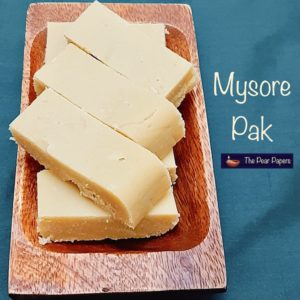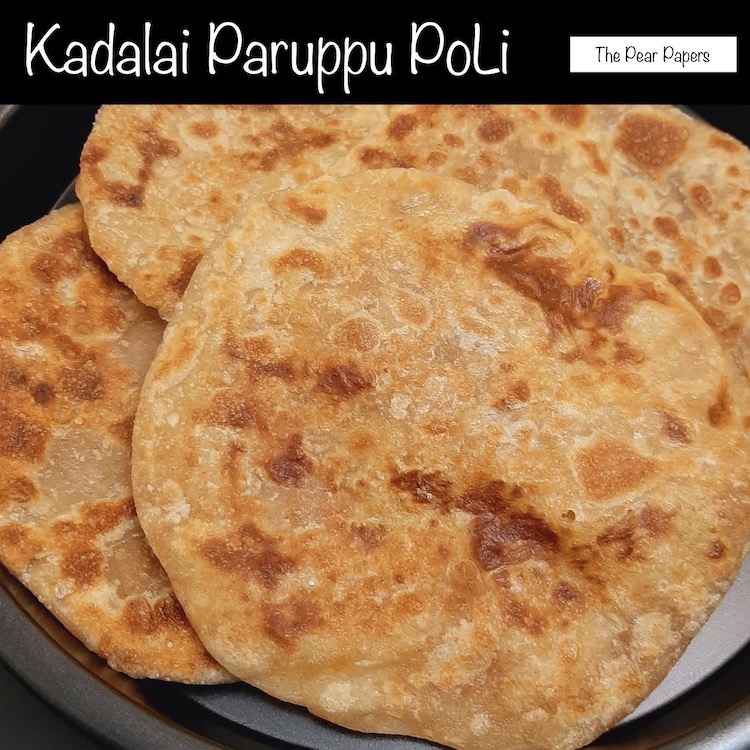
Kadalai Paruppu PoLi
Kadalai Paruppu PoLi is one of the traditional sweet dishes made during festivals in different parts of India. Kadalai paruppu is commonly known as split yellow dhal or split chick peas or bengal gram. This sweet dish is called by different names like Puran PoLi, Paruppu PoLi, Obbattu, Hollige etc in different regions/languages.
Kadalai Paruppu PoLi is made by making a soft dough with flour (for the outer covering), resting it for couple of hours, then spread with hand or rolled out, stuffed with boiled, mashed bengal gram sweetened with jaggery and coconut. This stuffed poLi is then spread out like paratha either with hand or with a rolling pin, cooked with ghee (check out my recipe for ‘How To Make Ghee‘ to make the most aromatic ghee at home) on a flat pan until golden on both sides.
The process may seem a little lengthy but you can conveniently divide the process into smaller parts and do at intervals to suit your time constraints. The outer dough can be prepared 3 to 4 hours in advance. In fact, longer the dough rests (maximum 5 to 6 hours), softer the poLi will be. The sweet filling can be done a day in advance too.
Other than kadalai paruppu, you can stuff PoLi with a variety of things like coconut, dry fruits, moong dhal, sweet potato, dates, a combination of these, or even spicy vegetables (called ‘kaara poLi’ meaning spicy poLi)!
Ingredients
Plain flour – 1 1/2 cups
Whole wheat flour – 1/2 cup
Salt – 1 pinch
Sugar – 1 tbsp
Unsalted butter – 1 tbsp
Water – as required
Sesame oil/Cooking oil – 3 tbsp
Chana dhal – 1 cup
Powdered/crushed jaggery – 1 1/2 cups
Fresh coconut (grated) – 1 cup
Cardamom powder – 1 tsp
Ghee – 3 tbsp (for the stuffing)
Ghee – as required to make the poli
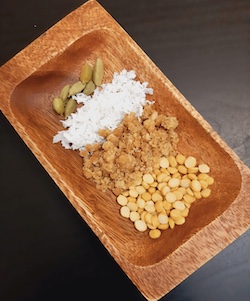
Yield
12 to 15 poLis
Prep time
3 hours resting time for the dough
Cook time
30 mins
Method
1) In a wide bowl, take plain and whole wheat flour. Add salt and sugar. Mix once for the salt and sugar to spread evenly. Add water little by little and mix the flour mixture gently to make a soft dough. Once the dough comes together add butter and knead it for at least 5 to 7 mins. This activates the gluten and the dough will become very soft and non-sticky after kneading for a few mins. Now pour all the oil on top of the dough and let it rest like this.. This oil keeps the dough supple and is also used to spread the dough later. Cover the bowl with a damp cloth and a lid on top. Let it rest for a minimum of 3 hours. Can rest the dough longer too (refer note 1).
2) While the dough is resting, take the bengal gram in a roasting pan and dry roast it on low flame for about 5 to 7 mins so the bengal gram gets roasted lightly without changing colour. After 7 mins transfer it to a bowl, add water, wash it twice and soak it in fresh water for 2 hours.
3) After 2 hours, cook the soaked bengal gram until soft (you can pressure cook for 2 whistles or cook in an open pan until done). Once cooked, drain the bengal gram in a colander and let it cool to room temperature.
4) While the cooked bengal gram is cooling take the jaggery powder in a pan, add enough water to cover it and heat it on medium flame, stirring continuously until all the jaggery melts. Now strain this jaggery water through a fine strainer to remove any impurities.
5) Take this strained jaggery water and boil on medium heat for nearly 5 to 7 mins. Switch off the heat then and let the jaggery water cool to room temperature.
6) Now take the cooked bengal gram in a mixer, add coconut and pulse it a few times. Add the jaggery water little by little (for the mixer to run) and grind into a smooth paste (use up all the jaggery water to grind the entire bengal gram and coconut to a smooth paste).
7) Take a heavy bottomed pan, heat it a bit and add 3 tbsp ghee. Add the ground bengal gram-jaggery mixture and start stirring. Keep the heat on medium and stir continuously until it thickens (takes around 8 to 10 mins) (see beginner’s tip). The stuffing should be thick, leave the sides of the pan and move with the spatula. Now add cardamom powder and mix completely. The stuffing for Kadalai Paruppu PoLi is now ready. Transfer this stuffing to a plate and allow it to cool down completely.
8) Once the stuffing cools down, take smaller portions to make lemon sized balls and set aside.
9) Take a small portion from the well rested dough and spread it on a greased wax paper with the tip of your fingers. Spread gently so that the edges are thinner than the center. Place the stuffing in the middle. Gently stretch and pull up the edges to close the stuffing in completely.
10) With greased hands or rolling pin gently flatten this stuffed dough ball evenly (make sure the stuffing doesn’t come out).
11) Heat a flat pan/tawa and grease it with 1/2 tsp ghee. Now gently lift the poLi from the wax paper and place it on the tawa. Drizzle some ghee around the edges and cook the poLi on low heat until both sides are cooked well and brown spots appear all over the poLi. Remove from heat and serve hot with some extra ghee (purely optional) on top.
Notes
- Resting the dough is very crucial for this recipe. A well rested dough will be super soft, nice and stretchy. You can make the dough even 5 to 6 hours before the actual cooking time. Though I wouldn’t recommend anything above 6 hours at room temperature as it starts to become stale beyond that.
- Normally the dough for any poLi is made with plain flour. The disadvantage with only plain flour is that the poLi tends to get a bit rubbery after one day. Adding a portion of whole wheat flour with plain flour keeps your poLis soft for longer.
- Traditionally, people would use fresh banana leaf as a base to flatten out the poLi instead of wax paper. Use banana leaves if you can get some!
Beginner’s Tips
- Use a long handled spatula while cooking the stuffing. The mixture splatters a bit until it thickens!
- If you are a beginner, use your finger tips instead of a rolling pin (like I’ve shown in the video) to flatten out the stuffed poLi. I wouldn’t suggest using rolling pin as it is difficult to control the pressure. The stuffing might squish out if more pressure is applied.
- Adding ghee gives great flavour to the Kadalai Paruppu PoLi. A mix of ghee and oil can also be used. Use at least half a tsp of ghee for each poLi so they stay soft for a long time.


You May Also Like
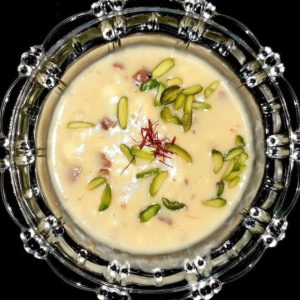
A very Paneer Diwali – Paneer Kheer
October 27, 2019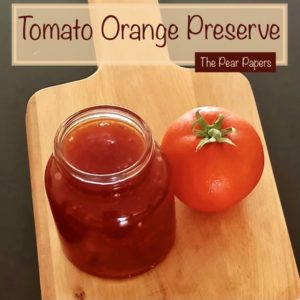
Tomato Orange Preserve
April 18, 2021